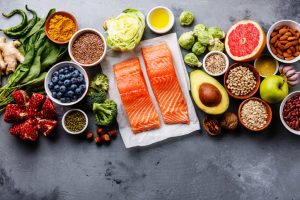Amino acids, often referred to as the building blocks of organic matter, are organic compounds that combine to form proteins.
When you consume and digest proteins, your body breaks them down into amino acids. These amino acids play a vital role in various functions, including providing energy, enhancing the immune response, supporting tissue growth and repair, and aiding muscle function and development.
There are 20 amino acids in total. Nine of them are essential amino acids, meaning we need to get them from our food. Nonessential amino acids can be produced by our bodies
Remember that you can only get essential amino acids from food, while your body can produce nonessential amino acids on its own.
Let’s go over a few examples of foods rich in both essential and nonessential amino acids.
Essential Amino Acids
Some of the best food sources of each of the nine essential amino acids are:
- Histidine: Meat, chicken, fish, soybeans, peas, oats, wheat, kidney beans, and dried bonito broth
- Isoleucine: Beef, chicken, pork, fish, milk, lentils, cheese, tofu, quinoa, and pumpkin seeds
- Lysine: Red meat, fish, cheese, milk, yogurt, legumes, and brewer’s yeast
- Leucine: Beef, venison, chicken, lamb, cashews, pistachios, pine nuts, almonds, beans, lentils, cheese, cocoa, and yogurt
- Methionine: Soy, nuts, beef, lamb, turkey, beans, pork, eggs, shellfish, and quinoa
- Tryptophan: Cheese, chicken, milk, egg whites, sunflower seeds, pumpkin seeds, sesame seeds, peanuts, turkey, fish, and soybeans
- Valine: Meat, chicken, eggs, whole grains, nuts, mushrooms, peanuts, and soybean products (such as edamame and tempeh)
- Threonine: Red meat, poultry, fish, cottage cheese, beans, lentils, seeds, and wheat germ
- Phenylalanine: Meat, soy, poultry, beans, nuts, nut butters, peas, avocados, pumpkin seeds, sunflower seeds, and sweet potatoes
Nonessential Amino Acids
The 11 nonessential amino acids include:
- Alanine
- Arginine
- Asparagine
- Aspartic acid
- Cysteine
- Glycine
- Glutamic acid
- Glutamine
- Proline
- Serine
- Tyrosine
Your body can convert essential amino acids into non-essential amino acids when necessary, so obtaining non-essential amino acids from your diet isn’t as crucial. However, you can still find non-essential amino acids in many of the same food sources, including:
- Beans
- Dairy
- Eggs
- Lentils
- Meat
- Nuts
- Quinoa
- Seeds
- Soy
A high-protein diet is crucial for obtaining enough essential amino acids. To ensure you’re getting all the necessary micronutrients and macronutrients, incorporate a variety of protein sources into your meals each day.
If you follow a plant-based diet, focus on vegetarian or vegan options such as nuts, beans, lentils, eggs, and soy. For those who consume animal products, choosing lean meats, fish, and seafood is wise, especially if you have a history of heart disease or want to support your heart health.





